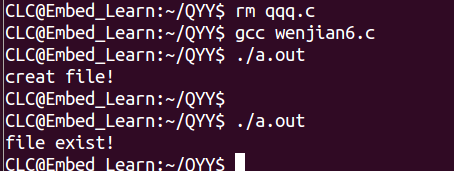
O_CREAT 函数已经用过了,若不存在就新建一个文件
我们来看看 O_EXAL 函数吧(若文件存在,则返回-1)
#include <sys/types.h>
#include <sys/stat.h>
#include <unistd.h>
#include<stdlib.h>
#include<fcntl.h>
#include<stdio.h>
int main()
{
int fd;
fd=open("./qqq.c",O_RDWR|O_CREAT|O_EXCL,0600);
if(fd==-1)
{
printf("file exist!\n");
}
else
{
printf("creat file!\n");
}
close(fd);
return 0;
}

成功了!
接下来看看 O_APPEND 函数
我们现在qqq.c这个文件中随便写一些东西

然后运行下面这个代码
#include <sys/types.h>
#include <sys/stat.h>
#include <unistd.h>
#include<stdlib.h>
#include<fcntl.h>
#include<stdio.h>
int main()
{
int fd;
char *buf="LLP IS MY WIEF!";
fd=open("./qqq.c",O_RDWR);
printf("fd=%d\n",fd);
int n_write=write(fd,buf,strlen(buf));
if(n_write!=-1)
{
printf("write %d byte to file\n",n_write);
}
close(fd);
return 0;
}
再打开qqq.c这个文件

会发现后面写的数据把之前的覆盖掉了。
然后我们加上O_APPEND后
#include <sys/types.h>
#include <sys/stat.h>
#include <unistd.h>
#include<stdlib.h>
#include<fcntl.h>
#include<stdio.h>
int main()
{
int fd;
char *buf="LLP IS MY WIEF!";
fd=open("./qqq.c",O_RDWR|O_APPEND);
printf("fd=%d\n",fd);
int n_write=write(fd,buf,strlen(buf));
if(n_write!=-1)
{
printf("write %d byte to file\n",n_write);
}
close(fd);
return 0;
}

就没有覆盖,而是紧接着之前的数据写入
接下来我们看看 O_TRUNC 函数
如果之前文件里面有内容,先把内容清零,然后写入新的。
假如还是刚才那个文件qqq.c里面有内容了,接下来运行这个代码
#include <sys/types.h>
#include <sys/stat.h>
#include <unistd.h>
#include<stdlib.h>
#include<fcntl.h>
#include<stdio.h>
#include<string.h>
int main()
{
int fd;
char *buf="FOREVER!";
fd=open("./qqq.c",O_RDWR|O_TRUNC);
printf("fd=%d\n",fd);
int n_write=write(fd,buf,strlen(buf));
if(n_write!=-1)
{
printf("write %d byte to file\n",n_write);
}
close(fd);
return 0;
}
运行结果为:

可见,之前的数据都没了
接下来还有一个create函数
#include <sys/types.h>
#include <sys/stat.h>
#include <unistd.h>
#include<stdlib.h>
#include<fcntl.h>
#include<stdio.h>
#include<string.h>
int main()
{
int fd;
fd=creat("/home/CLC/QYY/file01",S_IRWXU);
close(fd);
return 0;
}

create函数里面第一项是填需要创建文件的详细位置。